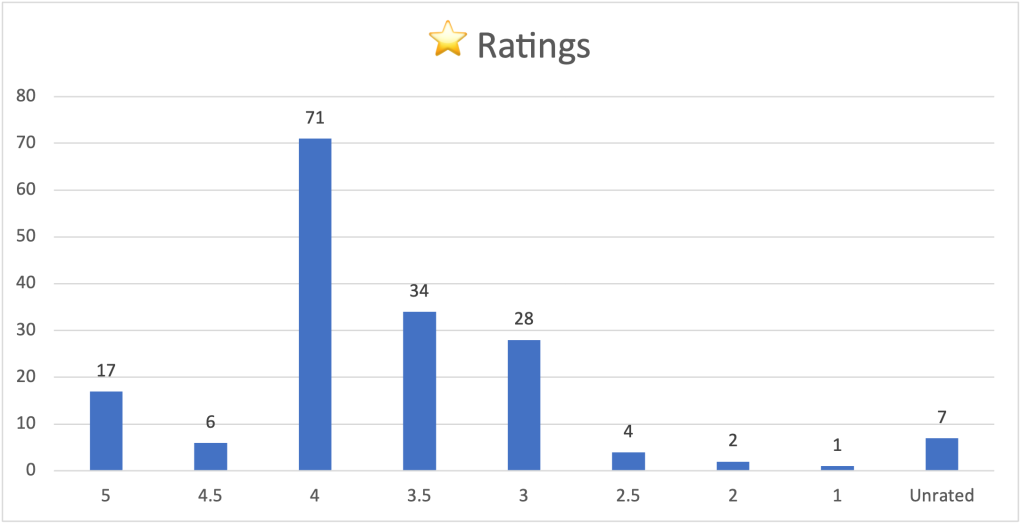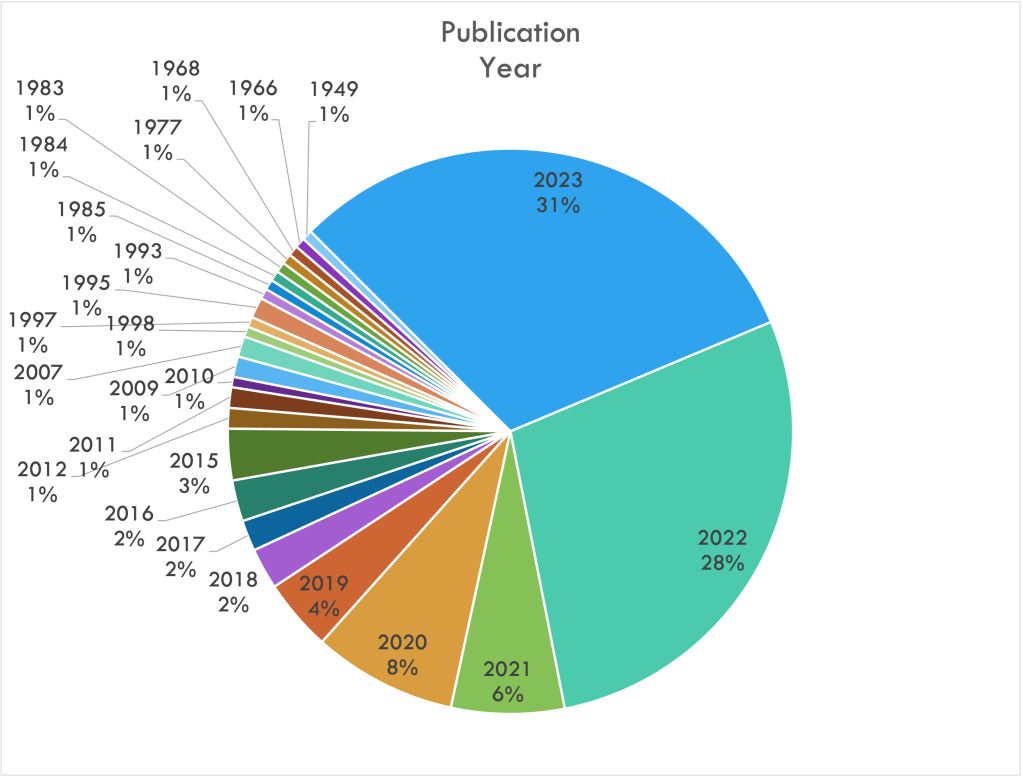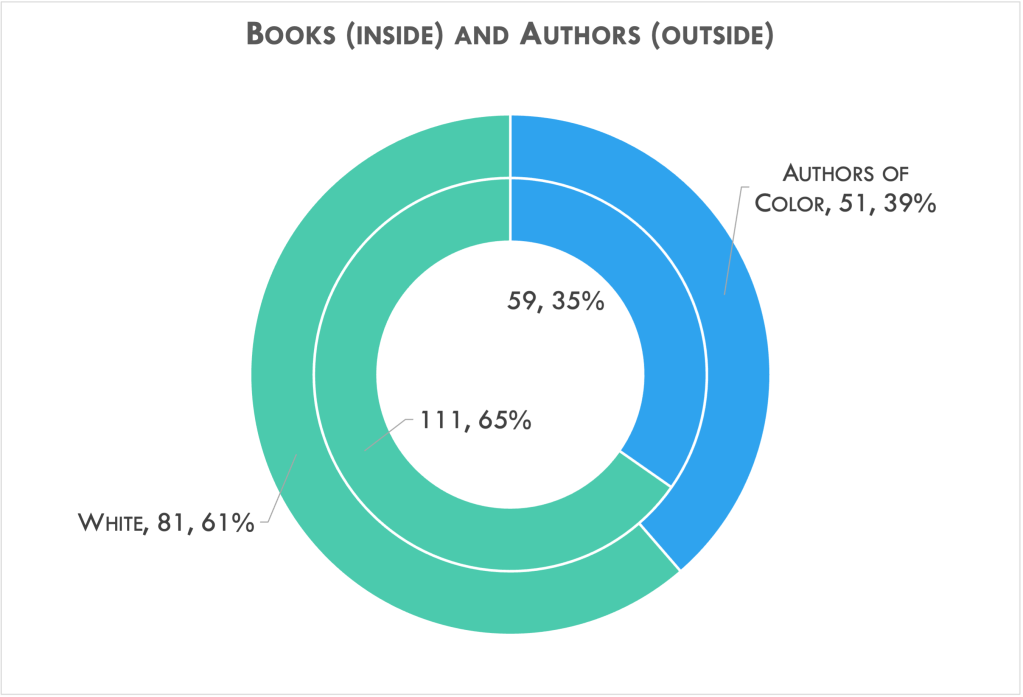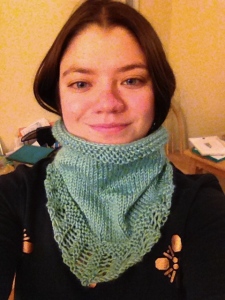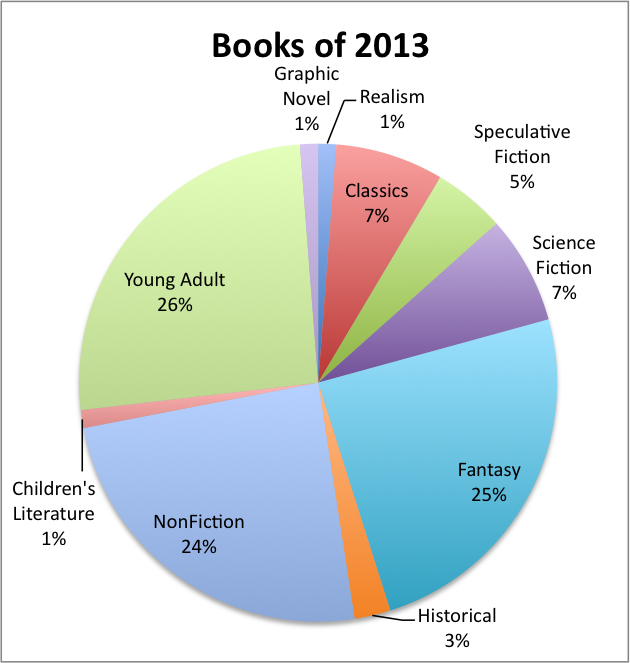Huh. 12 years now. That’s a lot of wordpress redesigns. I feel like I’m also starting to develop a reading list for picture books that I genuinely enjoy reading (or at least did the first 20 times that I read them) so perhaps I should write one of those up separately. I will not read green eggs and ham, I’m tired of it Sam-I-Am. Hashem only knows what my read count would look like if we covered every reread of Horton Hears a Who and Good Night Moon we experienced this year. Speaking of read count…

I observed last year that I was going to officially set my reading goal at 150 so that it would feel like “a push but not a struggle”. That was cute. I think it’s safe to say I read a lot this year. I also think this year was “a lot” so, you know, no actual judgment of myself on how much time I spent in books as a retreat.
And, I mean, this is my retreat. Reading is very specifically an escape and the place that I go when things become too much. It’s also the thing I do when I’m feeling calm and want to enjoy myself. Basically it’s like tea; the situation always calls for it. But specifically the idea that reading is escaping is one that I have to say a little more about. By which I mean I can shoehorn Tolkien into this conversation—as we all know I love to do—where he talks about disdaining literature that offers escape as “confusing, not always by sincere error, the Escape of the Prisoner and the Flight of the Deserter.”* I do read a fair amount of what might be called escapist literature and I also know that my good friend JRRT would not consider that weird month with a 24 hour long audiobook discussing the nature of freedom and the organization of early human societies to be Escape in the sense that fairy stories offer it, with their glimpse through silver glass of the far off green country. And yet. Books offer a chance to be elsewhere, whether in someone else’s land or someone else’s head, and invite us to try on someone else’s way of seeing the world. And then to come back and see this world anew and brighter. “[B]y the making of Pegasus, horses were ennobled.” In the thoughts of others, we find the way back to ourselves.
Two years ago I wrote about how I use books to make myself. The year after I wrote about how I use books to learn about the world. This year is about how books build the bridge between the two. (Tolkien would want to compare it to the Bifrost.) Who knows what I’ll have to say next year.
And I got to do that 170 times this year. Well, 162 times. Anything that got fewer than 3 stars doesn’t precisely count as escape, although one does appreciate the chance to get annoyed at something that does not really matter. Or, at least, *I* do. There was one 1 star book that finishing it actually counted as escape.
On that note, let’s talk about the ratings.
Basically 133 of the books I read were things I would consider pretty good, ranging from “solid but I had complaints” to “that was an enjoyable experience.” Given the option to rate something 3.5 instead of 3, I am pretty likely to take it. (Which is why I really do appreciate the nuance of Storygraph.) It’s the things that rise above that are most interesting, but we’ll get to those later, I promise.
To translate that into numbers, I read 77 print books, 61 audiobooks, and 32 ebooks
For comparisons sake, I read 20 more audiobooks this year than last year which accounts for the overall shift in numbers. (I also read approximately 10 fewer ebooks and 10 more print books, but that about evened out in the wash. I find that shift more interesting than the audiobook increase, which just comes from having my earbuds in more often.) Incidentally, I made the same remark last year about the percentage of audiobooks that I read growing at the expense of ebooks and it continues to be interesting and I continue not to know what to do with that information.
The other fascinating shift is that my nonfiction reading continues to grow. 25% of the books I read this year were nonfiction, which is a significant jump up from last year, which was 17% (as was 2021) and 2020, which was 6%.
But the really interesting thing, digging a little deeper into those numbers, is that I read 127 fiction books in 2020, 124 in 2021, 127 again in 2022, and 125 this year. So another way to look at my reading increase is that I keep adding more nonfiction to my reading list while my fiction consumption stays stable. So is it that I’m reading more audiobooks and so reading more? Or perhaps its the fact that I keep adding in nonfiction that makes a difference.
So preliminary research into this year suggests that those are one and the same. I am specifically listening to more nonfiction. 58% of my nonfiction consumption was through audio. If I just look at fiction, it’s about 25% audio, 25% digital, and 50% print, rather like last year. I don’t have very good data for earlier than that, but I could probably go and check. Maybe not now.
Anecdotally, I’m definitely seeking out more nonfiction that is a little outside of my normal interests and usually reading it via audiobook. I’m not sure I learn better via listening or simply that I am more likely to try something new if it is in audio form. It is also worth noting that I have yet to figure out how to read with my eyes while knitting so an audiobook is an opportunity to learn and craft at the same time. I am more likely to choose to listen to an audiobook rather than read the ebook precisely because I can do more things while listening. I still reserve print for things I really want and until someone comes up with an actually compelling argument for ereaders on Shabbat, I don’t see that changing.
The downside is that now I am very conscious of these choices and so any future data will be influenced by these preliminary findings, at least for the next week until I forget them.
Now for some fun data!
Once again, most of my reading comes from books published in the 2020s, although the 20th century continues its comback even if not at the same rate as last year. The 19th hasn’t reappeared this year either; possibly because nothing new has come out of it?
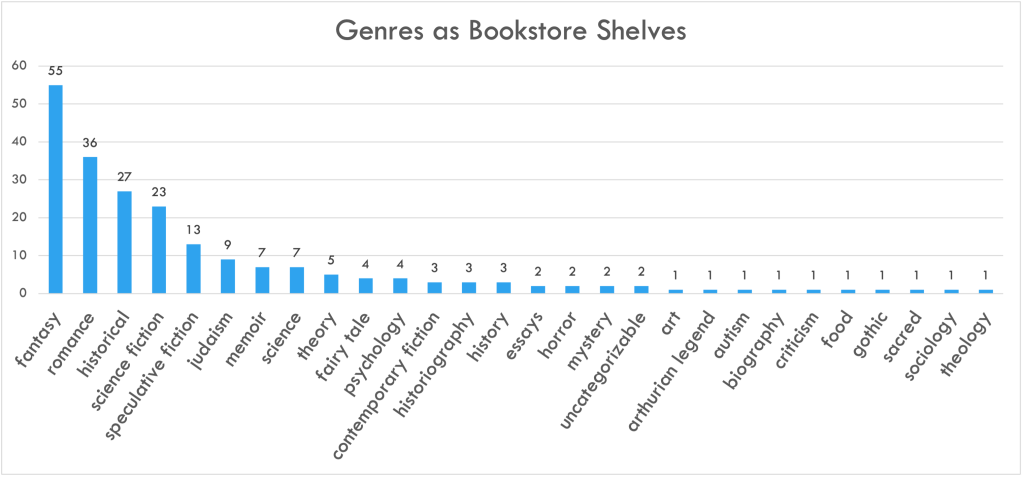
As a reminder, I often tag books as more than one genre so this will not add up to 170. This is just a sense of the topics that I covered this year. (With good old uncategorizable making its usual reappearance. It usually means speculative fiction, just weirder than usual.) I also love that Judaism, Sacred, and Theology are three distinct categories that may or may not overlap.
As a reminder, if you want to see this data broken out more or see which books fell into which categories for me, you can find nearly all of it visible on Storygraph, which is set so that you should all be able to see it.
And just a quick check-in on my ongoing project to keep track of authorial gender and to make sure that at least 1/3 of the books that I read every year are by Authors of Color. (Divergent readers for diverse reading.)
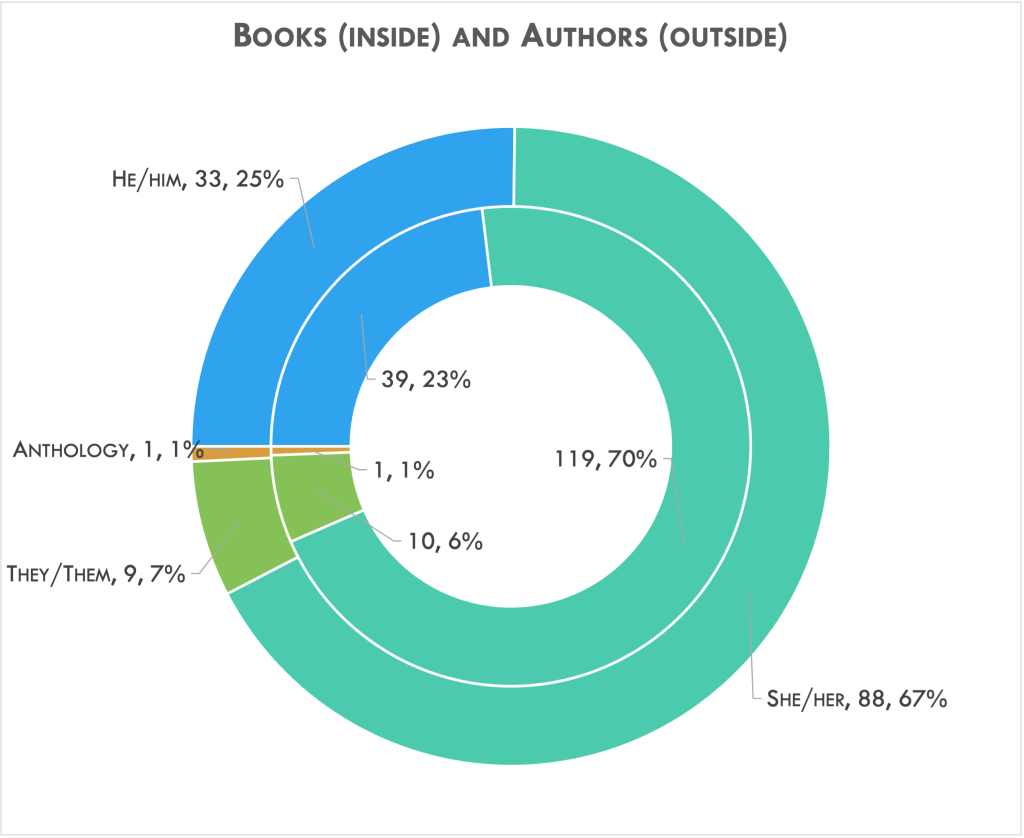
Every year I reevaluate whether this is, in fact, a useful metric and every year I fail to come up with a better way to make sure that my reading list stays diverse. While I always appreciate people on social media providing lists of BIPOC authors they enjoy reading, many of the same names keep coming up and I know whether I enjoy their work or not. It still feels like white authors have a certain amount of discoverability where I just trip over new people writing things that interest me, but I have to go out of my way to find new BIPOC authors. Also, white authors tend to have a massive back catalog for me to fall down and I can end up reading five or six books by a single author and many BIPOC authors are earlier in their careers and don’t have that kind of back catalog.
I started this practice in 2018 after 2017 was “I’m going to try to read more books by authors of color” and I got to about 1/4. Which, to be clear, was a big improvement. But my reading list has been far more diverse and interesting and better if I make it an actual rule. At the end of the day, clear metrics that I can easily gauge are the single best way to keep me accountable to myself. There’s a lesson there somewhere.
With all that out of the way, let’s get to the recommendations!
In my ongoing desire to eschew ranking my top ten for any number of reasons (or even sticking to ten), we are continuing last year’s approach of making up awards ranging from the plausible to the extremely niche and giving them to the books for which they were invented. The number of books remains somewhere in between 10-14, depending on how many additional books I successfully sneak in.
Best fairy tale retelling (and the competition was stiff this year, the runners-up are also amazing):
White Cat, Black Dog by Kelly Link. This series of short stories was absurdly good on every level and what Link does by modernizing the setting and allowing the plot to change in order to fit without ever removing the inherent magic of the fairy tale is stunning. Also she retold both East of the Sun, West of the Moon and Tam Lin and I am a sucker for both of those stories.
Best use of second person in a narrative:
The Spear Cuts Through Water by Simon Jimenez. The thing about second person narratives is that they generally are just annoying until someone comes along and actually does something wonderful with the question “why are you being told your story” and Jimenez absolutely does. Because it’s simultaneously a story about displacement and the place of narrative and our relationship to old stories and also a really good story about gods and monsters and the difference between escape and repentance. I said I wasn’t ranking, but this may be my favorite book this year.
Best depiction of a religiously observant protagonist in an epic fantasy:
The Adventures of Amina Al-Sirafi by Shannon Chakraborty. This is a very fun pirate adventure that does a really good job of imagining mythological creatures into the world and Chakraborty has always had a very good handle on writing fantasy and has gotten even better in this new series. The thing that makes this book extraordinary rather than just good fantasy is that she writes Amina as an observant Muslim woman who believes and is bound by her faith and whose missteps are normal (she drinks alcohol in a way that reminds me of eating “hot dairy out”), but who is also doing all the other things people do. Religious characters so rarely get to be anything other than clergy or fanatics and it’s so nice to see this done right.
The Beyond the Golem Award for wonderful Jewish fantasy:
When the Angels Left the Old Country by Sacha Lamb. Speaking of wonderful religious characters, this book was glorious in how it both dove into Jewish myths and held onto the lived experience of being Jewish throughout.The angel and demon chavruta at the heart of the story was beautiful and perfect and there was a single throwaway joke about a golem and nothing else and, while I love a good Frankensteinian hunk of clay, nothing makes me happier than seeing the richness of Jewish folklore explored beyond that. (This award was nearly entitled “To boldly go-lem” but I thought that was too confusing.)
The “I was bawling, you should read it!” award:
A Living Remedy by Nicole Chung. Sometimes I read memoirs because seeing the ways that other people make sense of their life stories and turn their pain into art gives me hope for the world. Sometimes I read memoirs because the author used to write for and edit The Toast. I came for the latter and stayed for the former.
Honorable memoir mention is The White Mosque by Sofia Samatar, which is weirder but also wonderful and a glorious story about faith and the places people have been and worshipped and how race complicates the relationship between co-religionists and also the history of Mennonites in Uzbekistan is fascinating.
Book that most compellingly shook my brain out and put it back in aired out and in better order:
Enchantment & Wintering, both by Katherine May. Read Wintering first. I think Enchantment works better as a follow-up, but I really appreciated them both and I keep turning the idea of hierophany that May introduces in Enchantment over in my head. (Hierophany – when we make something the object of our worshipful attention, we transform it into an object of the sacred. But it’s about seeing the wonder that is there not about projecting the divine onto it.) Also I learned the first chapter of tractate Chagigah this past semester so the idea of that which is sanctified and that which is made sacred is kicking around my brain.
Best use of the word Umwelt:
An Immense World by Ed Yong. I loved this book. It’s not easy to write what is basically a list of animal facts as a compelling story but wow does Yong manage. If you’ve ever stared in wonder at a fish in an aquarium staring back at you or get annoyed when people talk about five senses, this is a great choice of a book. Also for people who enjoy nature documentaries.
Runner up: Naming Nature: The Clash Between Instinct and Science by Carol Kaesuk Yoon. I love a good history of science book and Yoon does an awesome job here, but this book was specifically useful in concretizing an idea about how I understand halakha and I don’t think I’ll ever be able to go back.
Most Obscure Work by a Well Known Author:
Worlds of Exile and Illusion by Ursula K. Le Guin. This collection of three of Le Guin’s earlier novels really capture the way that she has always been doing interesting things especially when it comes to thinking about how people live in their worlds and how cultures do cultural things. Not to mention how economic and technological divides sow chaos. These books are a little less intricate than her later works and part of their appeal was precisely that she was still asking so much of even straightforward plots.
Book that most compellingly shook my brain out and put it back in the wrong way round:
When We Cease to Understand the World by Benjamin Labatut. I don’t even know what to do with this book, how to talk about it or even how to recommend it. It is weird and playing with history and fiction in interesting ways even as it is setting out to think about what it’s like to live in a world that is not unknown, but unknowable. How do we live with that? How do we understand the relationship between discovery and destruction? What do you do with a book that treats history itself as unknowable even as it invents stories about it? Should I take up gardening?
Book that is as old as I am that I never read and that is, in fact, as good as everyone says:
The Last Unicorn by Peter S. Beagle. This is a masterpiece, as is the movie that it engendered (in all its 80s animated glory), and I’m kind of glad I didn’t read it as a child because then I could read it for the first time as an adult and just sit with it. It’s a story with strangeness and depth and while I appreciate modern literature a lot, I also sometimes miss the willingness of authors in the 80s and 90s to point blank refuse to explain things because that’s not how fairy stories work. This book is not about the following things, but it is absolutely recovery, escape, and consolation.
Maybe next year I’ll only read 20 books that way I don’t feel bad leaving off so many wonderful books. If you want more recommendations, anything that got 5 stars or 4.5 stars come highly recommended, although I mentioned many of them already.**
See you next year!
——-
*All citations are from Tolkien’s essay “on Fairy Stories”. Next year I’ll aim for the monsters and the critics?
**With the caveat that, realistically, Verlyn Flieger’s book on language and logos in the Silmarillion is 5 stars for a very particular reader (it’s me. hi.) but maybe not if you’re not into that thing. So, you know, common sense and all that.

